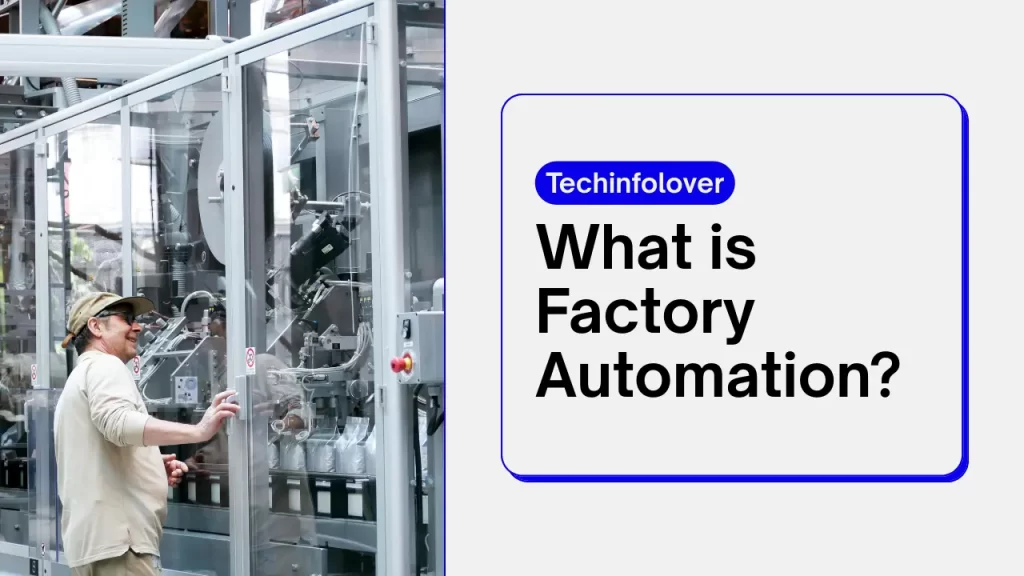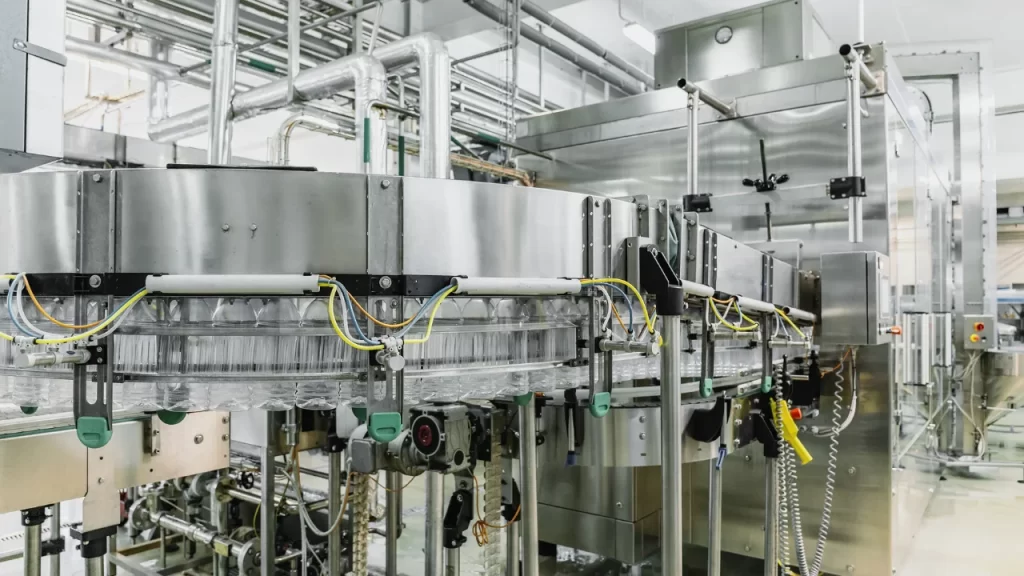Introduction
As global manufacturing faces pressure to produce faster, cheaper, and with higher precision, factory automation has become essential. From robotics to AI-driven quality control, automated systems now dominate modern production lines, making industries more efficient, safe, and competitive.
In this in-depth guide, we’ll explore what factory automation means, its core components, benefits, industry applications, technologies, challenges, and future trends. Whether you’re a business owner, engineer, or tech enthusiast, this article will give you valuable insights into how automation is transforming factories worldwide.

What is Factory Automation?
Factory automation refers to the use of control systems such as computers, robots, and information technologies to manage and streamline manufacturing processes with minimal human intervention.
It includes:
- Mechanical automation (e.g., robotic arms)
- Electrical automation (e.g., sensors and actuators)
- Digital automation (e.g., AI, machine learning, and IoT)
By integrating these technologies, factories can operate with higher consistency, fewer errors, and round-the-clock productivity.
Types of Factory Automation Systems
-
Fixed (Hard) Automation
Designed for mass production of a single product. Once set up, it’s difficult to modify. -
Programmable Automation
Suitable for batch production where product types or configurations vary. -
Flexible (Soft) Automation
Highly adaptable systems that switch between different tasks quickly with minimal reprogramming. -
Integrated Automation Systems
A fully connected environment where machines, software, and data platforms work together to optimize workflows.
Key Benefits of Factory Automation
1. Improved Efficiency and Throughput
Automated systems can operate 24/7 with minimal downtime, significantly increasing production capacity.
2. Higher Product Quality
Automation reduces human error, ensuring consistent precision and quality across production cycles.
3. Reduced Operational Costs
While the upfront cost is high, automation lowers long-term expenses through labor savings, less rework, and waste reduction.
4. Enhanced Worker Safety
Dangerous or repetitive tasks are performed by machines, reducing injuries and improving workplace conditions.
5. Real-Time Data and Insights
IoT and analytics tools provide real-time monitoring, predictive maintenance, and operational optimization.
Technologies Powering Factory Automation
1. Robotics and Robotic Arms
Used for welding, assembly, packing, and more. Industrial robots improve speed and precision.
2. Programmable Logic Controllers (PLCs)
These are the control units that automate tasks such as conveyor movement, timing, and machine logic.
3. Human-Machine Interfaces (HMI)
Touchscreens and control panels allow workers to interact with and manage automation systems.
4. Supervisory Control and Data Acquisition (SCADA)
SCADA systems enable real-time data collection and centralized control of industrial processes.
5. Artificial Intelligence (AI) & Machine Learning (ML)
AI enhances decision-making, fault detection, and adaptive responses in manufacturing workflows.
6. Industrial Internet of Things (IIoT)
Smart sensors collect data on temperature, vibration, pressure, etc., for remote monitoring and optimization.
7. Computer Vision
Used for automated inspection, quality control, and object recognition tasks.

Real-World Applications of Factory Automation
Automotive Industry
- Robotic welding, assembly, and painting
- AI for defect detection and predictive maintenance
Electronics Manufacturing
- Automated component placement on circuit boards
- Cleanroom robotics for micro-scale precision
Food & Beverage
- Robotic arms for packaging and palletizing
- Sensors to monitor temperature and hygiene
Pharmaceutical Industry
- Automated pill sorting and packaging
- Validation systems for FDA compliance
Textile and Apparel
- Cutting, dyeing, and folding automated through machines
- AI for demand forecasting and supply chain efficiency
How Factory Automation Enhances Quality Control
- Vision systems inspect for defects in real-time
- Closed-loop feedback adjusts production in response to variations
- Statistical Process Control (SPC) automates quality monitoring
Automation ensures each unit meets precise specifications, reducing waste and returns.
The Role of AI and Machine Learning in Factory Automation
AI is transforming how factories operate by:
- Detecting anomalies before breakdowns occur
- Optimizing production schedules based on demand patterns
- Automating decision-making in real time
- Enabling autonomous robotics to adapt to changing conditions
With machine learning, systems become smarter over time, improving accuracy and operational efficiency.
Challenges in Implementing Factory Automation
1. High Initial Investment
Robots, sensors, and software can be expensive, especially for small and medium businesses.
2. Integration Complexity
Retrofitting automation into legacy systems or multi-vendor setups requires careful planning.
3. Skilled Workforce Shortage
Technicians must be trained to manage, repair, and program advanced systems.
4. Cybersecurity Risks
Connected machines and cloud platforms increase the risk of hacking or data breaches.
5. Customization and Flexibility
Overly rigid systems may struggle to handle product variations or new product designs.
Future Trends in Factory Automation
1. Smart Factories (Industry 4.0)
Full integration of AI, IoT, and cloud computing for autonomous manufacturing.
2. Collaborative Robots (Cobots)
Robots that work safely alongside human employees to boost productivity without full replacement.
3. Digital Twins
Virtual models of equipment and processes to simulate, test, and optimize before real-world implementation.
4. 5G Connectivity
High-speed communication for real-time control, especially for remote factories.
5. Sustainable Automation
Energy-efficient machines and green manufacturing practices supported by AI-driven analytics.
Steps to Implement Factory Automation
-
Assess Your Needs
Identify manual bottlenecks, repetitive tasks, and quality issues. -
Set Clear Goals
Define what automation should achieve—cost savings, quality improvement, or faster output. -
Choose the Right Technology
Select scalable solutions that fit your product types, budget, and workforce. -
Train Your Team
Invest in upskilling your staff to maintain and manage automation systems. -
Monitor and Optimize
Use real-time data and KPIs to improve performance continually.

Factory Automation vs. Industrial Automation
While they overlap, here’s the difference:
| Factor | Factory Automation | Industrial Automation |
|---|---|---|
| Scope | Specific to manufacturing/factories | Broad, including power, utilities, oil & gas |
| Focus | Assembly, production lines | Process control, safety systems |
| Example | Automotive assembly robot | Oil refinery monitoring system |
Conclusion
Factory automation is no longer optional—it’s a necessity for manufacturers aiming to stay competitive in today’s global marketplace. With the right technologies and strategy, companies can scale faster, deliver better products, and reduce risks.
From AI-powered machines to smart analytics and IoT, automation is transforming traditional manufacturing into intelligent, agile, and scalable ecosystems.
Frequently Asked Questions (FAQs)
1. What is factory automation and why is it important?
Factory automation uses machines, software, and control systems to perform manufacturing tasks with minimal human input. It’s important because it increases productivity, improves product quality, reduces labor costs, and enhances safety.
2. How does factory automation work?
Factory automation works through a combination of hardware (like robotic arms, sensors, and conveyors) and software (such as PLCs and SCADA systems) to control, monitor, and optimize industrial processes automatically.
3. What are the main types of factory automation?
The four main types include:
- Fixed Automation: High-volume, repetitive tasks
- Programmable Automation: Flexible for batch production
- Flexible Automation: Quick changeovers for diverse tasks
- Integrated Automation: Fully connected systems using AI and IoT
4. What industries benefit most from factory automation?
Industries that benefit include automotive, electronics, food & beverage, pharmaceuticals, packaging, aerospace, and textiles. These sectors rely on high precision and volume production.
5. What are the advantages of automating a factory?
Key benefits:
- Faster production rates
- Consistent product quality
- Reduced human error
- Enhanced workplace safety
- Lower long-term operational costs
6. What technologies are used in modern factory automation?
Technologies include:
- Robotics
- PLCs (Programmable Logic Controllers)
- IoT devices
- Artificial Intelligence and Machine Learning
- Vision systems
- SCADA and MES software
7. Is factory automation expensive to implement?
Initial costs can be high due to equipment, integration, and training. However, the long-term savings from improved efficiency, fewer errors, and reduced labor often provide a strong ROI.
8. Can small businesses adopt factory automation?
Yes. Many automation solutions are scalable and modular, making them accessible to small and medium-sized enterprises (SMEs) looking to increase efficiency and reduce costs without major overhauls.
9. Does factory automation eliminate jobs?
Not necessarily. While some manual tasks are replaced, automation creates new jobs in programming, maintenance, robotics, data analysis, and system management. It shifts the workforce toward higher-skilled roles.
10. What is the future of factory automation?
The future includes:
- Smart factories powered by AI and IoT
- Cloud-based production management
- Collaborative robots (cobots)
- Real-time analytics for predictive maintenance
- Sustainable and energy-efficient automation



